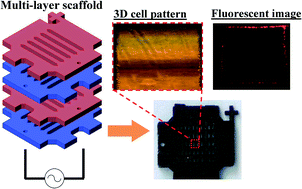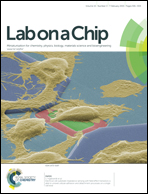Three-dimensional cell manipulation and patterning using dielectrophoresis via a multi-layer scaffold structure†
Abstract
Cell manipulation is imperative to the areas of cellular biology and tissue engineering, providing them a useful tool for patterning cells into cellular patterns for different analyses and applications. This paper presents a novel approach to perform three-dimensional (3D) cell manipulation and patterning with a multi-layer engineered scaffold. This scaffold structure employed dielectrophoresis as the non-contact mechanism to manipulate cells in the 3D domain. Through establishing electric fields via this multi-layer structure, the cells in the medium became polarized and were attracted towards the interior part of the structure, forming 3D cellular patterns. Experiments were conducted to evaluate the manipulation and the patterning processes with the proposed structure. Results show that with the presence of a voltage input, this multi-layer structure was capable of manipulating different types of biological cells examined through dielectrophoresis, enabling automatic cell patterning in the time-scale of minutes. The effects of the voltage input on the resultant cellular pattern were examined and discussed. Viability test was performed after the patterning operation and the results confirmed that majority of the cells remained viable. After 7 days of culture, 3D cellular patterns were observed through SEM. The results suggest that this scaffold and its automated dielectrophoresis-based patterning mechanism can be used to construct artificial tissues for various tissue engineering applications.


 Please wait while we load your content...
Please wait while we load your content...